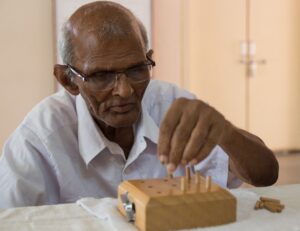Join a powerful, unprecedented alliance for better eye health for all.
Join IAPB-
Choose an alternate language here
The IAPB Vision Atlas projects a big increase in vision impairment, with a growing ageing population as one of the key drivers. India (and other middle-income countries) is currently enjoying a ‘demographic dividend’; a greater proportion of the population are of working age. However, the UN World population ageing report notes that India’s ageing population, the ‘elderly’, will grow from 8% in 2021 to 20% of the population by 2050—over 300 million people. By 2050, the percentage of elderly people will increase by 326%, with those aged 80 years and above set to increase by 700%, making them the fastest-growing age group in India. These sweeping demographic changes, coupled with changes in social arrangements, will trigger a complex set of health needs among the elderly in India. Eye health has the potential to be a good proxy for well-being, and the driver for a holistic approach to elderly care.
As India urbanises, an emerging approach to elder care has been ‘homes for the aged’—care homes–where the care of elderly people is managed by a set of professionals or voluntary organisations providing geriatric services. Such institutional care is opening up in urban and semi-urban centres across India—in fact, the number of such care homes is rising rapidly. These homes are either paid-for, or offer free or subsidised service. Typically, such homes are run by NGOs, religious or voluntary organisations with support from the government, or local philanthropy. These homes address the need for accommodation, timely care, and provide a sense of security to their inmates. However, the quality of service varies as these care homes in India lack regulatory oversight. Many homes lack clearly established standard operating procedures (SOP) and their referral paths to health care are informal. As families choose to send their ageing members over to care homes for the elderly, it is important for policy and public health infrastructure to prepare for these social changes.
L V Prasad Eye Institute undertook the Hyderabad Ocular Morbidity in Elderly Study (HOMES), with 1513 elderly participants enumerated from 41 homes for the aged in Hyderabad, Telangana, India. The study was designed with the following objectives:
DSI is the presence of both vision and hearing impairment in an individual. Previous studies have established the link between mental health and sensory impairment in different parts of the world. HOMES provides valuable insights into the prevalence of combined vision and hearing impairment, and the linkages with depression and mental health in elderly in the residential care for the first time.

The study also found that one out of every four elderly in residential care in Hyderabad had depression. The elderly with Dual Sensory Impairment were five times more at risk of depression. Also, depression was higher among those with single sensory impairment than in those without any sensory impairment.
Sensory impairments reduce independence and break long-established routines, and so, can be perceived as a grievous loss. These feelings are compounded by separation from family and community, along with a limited scope to be involved in daily activities like cooking and cleaning.
HOMES is one of the most comprehensive eye health studies done among the elderly in India and its findings apply to other urban locations in the country. Its two key findings are damning, especially as those accessing institutional care should have been screened for health complications. However, HOMES’ data also offers a silver lining: the burden of depression in institutional care can be reduced by addressing the avoidable causes of vision impairment. Providing spectacles or cataract surgery are health interventions that are easily done in urban settings.
HOMES also offers some insight into the path ahead. Health care for the elderly inmates of care homes needs to be multi-speciality. Many inmates have a multiple health conditions, and a piece-meal approach will only provide meagre improvements in their quality of life. A fair percentage cannot travel, so screening and support must reach their bedside. Finally, the approach needs to focus on integrating care for multiple morbidities, and must provide comprehensive health services.
Image credits: Dr Srinivas Marmamula